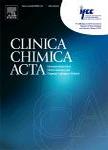版权所有:内蒙古大学图书馆 技术提供:维普资讯• 智图
内蒙古自治区呼和浩特市赛罕区大学西街235号 邮编: 010021

作者机构:Jiangnan Univ Affiliated Childrens Hosp Dept Med Lab Qingyang Rd 299 Wuxi 214023 Jiangsu Peoples R China Nanjing Med Univ Affiliated Wuxi Peoples Hosp Dept Resp & Crit Care Med Wuxi 214023 Jiangsu Peoples R China Jiangsu Sunlant Bioengn Co Ltd Wuxi 214038 Jiangsu Peoples R China
出 版 物:《CLINICA CHIMICA ACTA》 (Clin. Chim. Acta)
年 卷 期:2025年第565卷
页 面:119966页
核心收录:
学科分类:1006[医学-中西医结合] 1002[医学-临床医学] 1010[医学-医学技术(可授医学、理学学位)] 10[医学] 100602[医学-中西医结合临床]
基 金:Major Projects of Precision Medicine of Wuxi Health Committee, China [J202001] Top Talents Project of Wuxi Taihu Lake Talent Plan Project of "Taihu Light" Scientific and Technological Innovation (Medical and Health Technology Challenge) of Wuxi City, China [Y20232021]
主 题:Fully automated chemiluminescence Egg white Multi-component detection Pediatric allergens
摘 要:Background: Allergen testing has emerged as a pivotal component in prevention and treatment strategies for allergic diseases among children and the utilization of specific IgE (sIgE) through a fully automated chemiluminescent microarray immunoassay (CLMIA) has emerged as a promising trend in the simultaneous detection of multiple allergenic components of children. Methods: The accuracy and reliability of CLMIA were verified using children s serum samples that concentrated on allergens. the allergens. The clinical diagnostic practicability of CLMIA was assessed through comprehensive evaluations including measurements of the limit of detection (LOD), intra-batch, and inter-batch precision, linearity analysis, the cross-contamination rate, and the concordance rate with the Phadia system. Results: After the optimization process of CLMIA, the LODs for allergens were calculated to be below 0.01 kU/L, demonstrating the high sensitivity of CLMIA. All components exhibited good linearity within the range of 0.1-100.0 kU/L and the coefficient of determinations (R-2 0.99). The data of intra-batch precision (85 %) and the Kappa coefficients (0.8), suggesting the close alignment of CLMIA and the Phadia system and showing the satisfactory clinical potential of CLMIA in children s allergy disease. Conclusions: The application of CLMIA has been promising in allergen testing, especially for detecting multiple allergenic components in children.